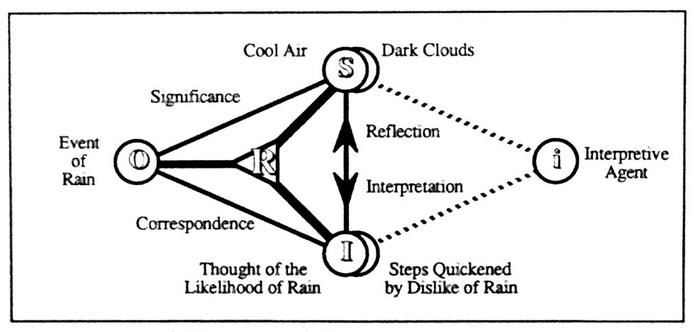Interpreter and Interpretant • Selection 7
• https://inquiryintoinquiry.com/2025/01/15/interpreter-and-interpretant-selection-7-a/
Learning —
Rules in a knowledge base, as far as their effective content goes, can be obtained by any mode of inference. For example, consider a proposition of the following form.
• B ⇒ A, Just Before it rains, the Air is cool.
Such a proposition is usually induced from a consideration of many past events. The inductive inference may be observed to fit the following pattern.
• Case : C ⇒ B, In Certain events, it is just Before it rains.
• Fact : C ⇒ A, In Certain events, the Air is cool.
────────────────────────────────────
• Rule : B ⇒ A, Just Before it rains, the Air is cool.
However, the same proposition could also be abduced as an explanation of a singular occurrence or deduced as a conclusion of a prior theory.
References —
Awbrey, J.L., and Awbrey, S.M. (1995), “Interpretation as Action : The Risk of Inquiry”, Inquiry : Critical Thinking Across the Disciplines 15(1), 40–52.
• https://www.pdcnet.org/inquiryct/content/inquiryct_1995_0015_0001_0040_0052
• https://www.academia.edu/57812482/Interpretation_as_Action_The_Risk_of_Inquiry
Dewey, J. (1910), How We Think, D.C. Heath, Boston, MA. Reprinted (1991), Prometheus Books, Buffalo, NY.
• https://www.gutenberg.org/files/37423/37423-h/37423-h.htm
Resources —
Survey of Abduction, Deduction, Induction, Analogy, Inquiry
• https://inquiryintoinquiry.com/2024/02/27/survey-of-abduction-deduction-induction-analogy-inquiry-4/
Survey of Semiotics, Semiosis, Sign Relations
• https://inquiryintoinquiry.com/2024/01/26/survey-of-semiotics-semiosis-sign-relations-5/
#Peirce #Logic #Semiotics #SignRelations #TriadicRelations
#Interpretation #Interpreter #Interpretant #Hermeneutics
#JohnDewey #Inquiry #Abduction #Deduction #Induction
#Abstraction #HypostaticAbstraction #Reflection

